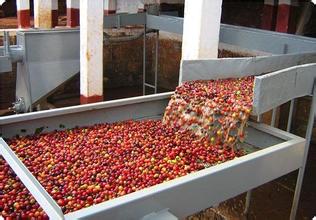Coffee utensils: detailed introduction of PROBAT coffee roaster in Germany
[brand profile]
In 1864, due to the construction of a railway, AlexiusvanG ü lpen, a pioneer of raw coffee beans in Emmerich, Germany, had a whim to extend freshly roasted coffee beans to retailers in other regions. The first problem to be solved, however, is the need for a high-output bean dryer.
So I got to know TheodorvonGimborn, a local engineer in Emmerich. After four years of research and development, he finally developed the first large bean dryer with high output in 1868, and also established the EmmericherMaschinenfabrik&Eisengie é ereivanG ü lpen,Lensing&vonGimborn Company, the predecessor of PROBAT. Until 1880, the company continued to grow with an astonishing sales volume of more than 600 bean dryers a year; in 1900, the sales of bean dryers exceeded 50000; the 100,000th was proudly sold in 1938, and the company officially changed its name to PROBAT-Werke. In the vast number of sales, 80% of the sales come from exports and are sold in more than 60 countries around the world.
[product characteristics]
PROBAT's bean baking equipment, Probatino with a capacity of 1.2kg, and rollers for 5kg and 12kg ProbatonePROBAT are designed to rotate back and forth, left and right, coupled with a unique leaf design to keep the coffee beans in a state of stir-frying forever, ensuring that the beans are heated evenly.

30% of the heat comes from direct conduction and radiation, while 70% is heated by hot air. In addition, the outside of the drum is covered with a layer of thermal insulation cotton, so that the internal temperature of the bean dryer is not easy to lose, and the heat storage effect is excellent. Because of this, PROBAT can make it easier for operators to achieve similar quality in every baking. In addition to baking equipment, PROBAT offers a variety of options, including laboratory testing equipment, coffee bean grading equipment and soot treatment and combustion equipment. Major international coffee bean merchants, such as LAVAZZA and UCC, use PROBAT equipment to bake coffee beans, and the quality is well-known.
PROBAT also produces cocoa, malt and nut processing equipment. Since its establishment in 1868, it has been committed to the development and production of a complete set of coffee processing and baking equipment, with distributors in Italy, the United States and Brazil, and 80% of its products are exported to Europe, North America and Central and South America. The Probat coffee roaster is sturdy and durable, unique in design, minimizes human interference in the working process of the equipment, has a simple operation interface, is easy to use, and is not prone to some common "baking defects" in coffee roasting.
In fact, PROBAT produces all kinds of equipment involved in the entire coffee industry chain. Roasters alone are divided into several categories:
1. PROBATSATURN centrifugal roaster series, the baking capacity in a single furnace ranges from 32kg to 640kg
2. PROBATJUPITER tangent roaster series, with a baking capacity of 50,750kg per furnace.
3. PROBATNEPTUNE drum roaster series, with a baking capacity of 80,640kg per furnace.
4. PROBATCOLOMBONOVA series roaster with a baking capacity of 120,500kg in a single furnace
5. PROBATBASIC basic roaster series, with a baking capacity of 150kg to 450kg per furnace.
6. Boutique coffee roaster series, with a baking capacity of 1kg to 50kg in a single furnace.
The roasting level above 5kg can be connected to a computer program to record the baking curve, or the coffee can be roasted automatically by the computer.
Source: Beresta's blog
Important Notice :
前街咖啡 FrontStreet Coffee has moved to new addredd:
FrontStreet Coffee Address: 315,Donghua East Road,GuangZhou
Tel:020 38364473
- Prev

Treatment of raw coffee beans: introduction to the operation method and purpose of washing method
Washing method: 1, select beans: put the harvested fruit in a water tank and soak for about 24 hours. At this time, ripe fruit will sink, while immature and overripe fruit will float up and can be removed. 2. Remove the pulp: use a machine to remove the skin and pulp, leaving only the coffee beans wrapped in the endocarp. At this time, there is a layer of mucous membrane on the outside of the beans, and the process of washing is
- Next

World-class coffee events and rules that baristas must know
The rule of World Barista Championship (WBC) World Barista Competition is that each contestant should produce 4 espresso, 4 cappuccino and 4 creative coffee based on Italian concentrate within 15 minutes. The judges will start from the use of the equipment, the blending of coffee beans, the skills of making coffee, and the quality of coffee products.
Related
- What is the meaning of lactic acid fermentation with coffee bean treatment?
- How to judge the state of foam by sound?
- How does the latte pull out the unicorn pattern? Come to get for a little trick to improve the flower pull!
- Will flower pulling affect the taste of the latte?
- Do you know the history of coffee?
- The difference between honey treatment and sun washing what is raisin honey treatment?
- What kind of milk can a novice use to make coffee foam to keep the foam longer? The correct method and skills of milking tutorial sharing
- Why do washed coffee beans taste sour? Flavor characteristics of washed Coffee
- Introduction to the skill of how to practice the size and height of water injection around the circle of hand-brewed coffee
- How do beginners practice coffee flower drawing from scratch?

